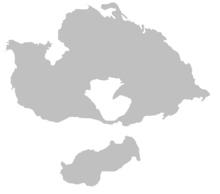Pangea Proxima
Pangea Proxima (also called Pangea Ultima , Neopangea and Pangea II ) is a possible future supercontinent . In accordance with the supercontinent cycle , Pangea Proxima could occur within the next 300 million years. This possible configuration, adopted by Christopher Scotese , owes its name to its resemblance to the former supercontinent of Pangea . Scotese later changed Pangea Ultima to Pangea Proxima (Next Pangea) to ease the confusion over the name Pangea Ultima, which could imply that it would be the last supercontinent.
concept
The concept was based on an examination of past cycles of supercontinent formation and breakup, not a current understanding of the mechanisms of tectonic change that are too imprecise to project that far into the future. "It's all pretty much imagination to start with," Scotese said. “But it's a fun exercise to think about what could happen. And you can only do it if you have a really clear idea of why things are happening in the first place. "
Supercontinents describe the amalgamation of all or almost all land masses on earth into a single, contiguous continent. In the Pangea-Proxima scenario, subduction on the western Atlantic , east of the Americas , leads to subduction of the mid-Atlantic ridge , followed by subduction that destroys the Atlantic and Indian ocean basins, closing the Atlantic and Indian oceans and the Americas to be reunited with Africa and Europe . As with most supercontinents, the interior of Pangea Proxima would likely become a semi-arid, temperature-prone desert.
Hypothesis on education
According to the Pangea-Proxima hypothesis, the Atlantic and Indian Oceans will continue to expand until new subduction zones bring the continents together again and form a future Pangea. It is predicted that most of the continents and micro-continents will collide with Eurasia, just as it did when most of the continents collide with Laurentia .
In about 50 million years a westward shift is predicted for North America and a shift to the east and possibly even south for Eurasia, which would move Great Britain closer to the North Pole and Siberia south to warm, subtropical latitudes. Africa is predicted to collide with Europe and Arabia , which will completely close off the Mediterranean and Red Sea , forming a supercontinent called Afro-Eurasia . A long mountain range (the Mediterranean Mountains) would then extend from the Iberian Peninsula across southern Europe to Asia . Some elevations are even predicted that their peaks will be higher than Mount Everest . Similarly, Australia is predicted to be stranded at the gates of Southeast Asia, crowding the inland islands together, forming another potential mountain range and forming a supercontinent called Afro-Euraustral Asia . It is now predicted that Southern California and Baja California have already collided with Alaska and that new mountain ranges have formed between them.
It is predicted that the Atlantic Ocean will stop expanding and then shrinking in about 125 million years because part of the Mid-Atlantic Ridge will have been subducted. In this scenario, a mid-ocean ridge between South America and Africa is likely to be subducted first; it is predicted that the Atlantic Ocean has narrowed as a result of subduction under America. The Indian Ocean will also have shrunk due to the subduction of the oceanic crust to the north into the Central Indian Rift. Antarctica is expected to shift north and collide with Madagascar and Australia, enclosing a remnant of the Indian Ocean (called the Indo-Atlantic Ocean) and forming the supercontinent Terra Orientalis .
If the last part of the Mid-Atlantic Ridge is subducted below the American continent, the Atlantic Ocean is expected to close rapidly. It is predicted that the Atlantic will be closed in 200 million years. It is predicted that North America has already collided with Africa, but is in a more southerly position than where it drifted. For South America , it is predicted that it completely encloses the southern tip of Africa and the Indo-Atlantic Ocean. The Pacific Ocean will have broadened to encompass half of the earth .
See also
Alternative hypothetical future supercontinents are:
literature
- Nield, Ted: Supercontinent: Ten Billion Years in the Life of Our Planet, Harvard University Press, 2009, ISBN 978-0674032453
Individual evidence
- ^ Caroline Willams, Ted Nield: Earth's next supercontinent . In: New Scientist . 196, No. 2626, 2007, pp. 36-40. doi : 10.1016 / S0262-4079 (07) 62661-X .
- ^ Continents in collision: Pangea Ultima . NASA Science News. October 6, 2000.
- ↑ Jeffrey S. Kargel: New World . In: Mars: a warm, weather planet . Springer, 2004, ISBN 978-1-85233-568-7 .
- ^ William J. Broad: Long-Term Global Forecast? Fewer Continents . In: The New York Times , January 9, 2007.
- ^ Our globe in next 50 million years , Oregon State University
- ↑ Christopher R. Scotese: The Atlantic Ocean begins to Close . In: Paleomap Project . Retrieved March 24, 2012.
- ↑ a b Christopher R Scotese: "Pangea Ultima" will form 250 million years in the future . In: Paleomap Project . Retrieved March 13, 2006.
Web links
- Four possible future supercontinents
- What planet Earth might look like when the next supercontinent forms - four scenarios , from November 27, 2018
- This is what the next supercontinent should look like , on welt.de on November 28, 2018.
- Four possible future supercontinents
- What Will Earth Look Like When the Next Supercontinent Forms? - NewsWeek
